|
Read more :
|
|
|
|
Sandžak :
|
|
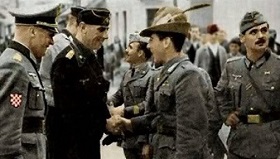
|
|
The Sandžak was from the April, 29th, 1941 for 6 months part of the Independent State of Croatia.
At this date a stamp set, limited to 99 sets, was issued and given to the some members of the croatian customs members and Ustaša (all croatian muslims).
To honour this annexion, local patriots from the
Sandžak who haven´t forgot this event have issued a set of 24 stamps with landscape-motives from the Sandžak at April, 29th, 2024.
[ READ MORE ] [ BUY HERE ]
|
|
|
|
|
|
Prinz Eugen Gau :
|
|
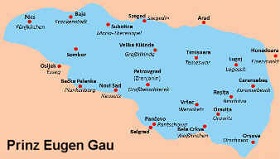
|
|
Before the war III. Reich against the in theeses days existing Kingdom of Yugoslavia, the Germans threatened the Hungarians that if they did not participate in that war, the Volksdeutsche would declare a German state at the territory of Bačka, Banat and eastern Syrmia all the way to Belgrade. That German state was supposed to be connected with a corridor that would go partly around the Danube river to the territory of III. Reich, that is, to the Slovenian Prekomurje, which was then part of III. Reich.
After the proclamation of the Independent State of Croatia April 10, 1941 this plans didn´t stop and the Volksdeutsche planed the proclamation of that state at the birthday of Adolf Hitler at April 20, 1941. They had prepared 3 stamps with overprints on hungarian stamps, but the III. Reich didn´t support this plans, because they don´t want to have problems with the new state, the Independent State of Croatia and also not with Hungary.
The Hungarians were afraid of a possible realisation of such a exteritorial german territory and annexed first the Bačka at the April 11, 1941 and some days later Međimurije of the Independent State of Croatia at the April 16, 1941 so that a corridor between a possible "Prince Eugen Gau" and the III. Reich couldn´t be realized without a war between the Allies Hungary and the III. Reich.
[ READ MORE ] [ BUY HERE ]
|
|
|
|
|
|
Prinz Eugen Division :
|
|
The Volksdeutsche from the Independent State of Croatia issued overprints on German stamps of the “Day of Wehrmacht” in 1943 and 1944, which was given to the new members of the division "Prinz Eugen".
[ READ MORE ] [ BUY HERE ]
|
|
|
|
|
|
”Bosniaks” are Croats!
|
|
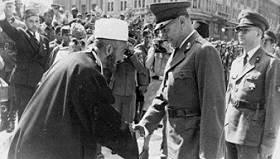
|
|
Regardless of the fact that the Croatian Muslims from Bosnia only reinvented themselves as a separate nation in 1991, they remain genetically Croats. This is not only evidenced by the largest genetic institute in Vancouver (Canada) but also by countless statements from Croatian Muslims from Bosnia over the past centuries.
[ READ MORE ]
|
|
|
|
|
|
Kuna and Banica :
|
|

|
|
We offer you very hard to find coins of the Independent State of Croatia and the 2nd exile.
In 1991 the german military camaradery “Handschar” issues coins in various metals in a limitation of only 200 coins :
- 25 Banica, 23,3 mm : 50 years of Sandžak annexion
- 50 Banica, 24,3 mm : Croatian warrior
- 1 Kuna, 25,7 mm : Handžar
- 1 Kuna, 25,7 mm : Coat of arms of Handžar, Kama and Prinz Eugen
- 2 Kuna, 28,0 mm : HOS
- 2 Kuna, 28,0 mm : Croatian State Labour Service
- 5 Kuna, 30,0 mm : Marija Oršić
- 5 Kuna, 30,0 mm : Frane Tente
- 10 Kuna, 32,0 mm : Beware of Četniks and Partisans
- 10 Kuna, 32,0 mm : Black Legion and Jure Francetić
- 50 Kuna, 39,0 mm : Poglavnik Dr. Ante Pavelić
Read all about the currency of the Independent State of Croatia : [ HERE ] [ BUY HERE ]
|
|
|
|
|
|
The truth about the victims :
|
|
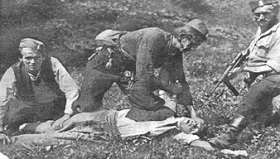
|
|
Enough of the Serbian lies: before World War II and after World War II, there was a census in the Serbian-dominated Kingdom of Yugoslavia and in the Serbian-dominated communist Yugoslavia, which showed 1,024,000 more Serbs and
1,230,000 fewer Croats, as well as 140,000 fewer Germans.
Read more : [ HERE ]
|
|
|
|
|
|
|
|
|
|
|
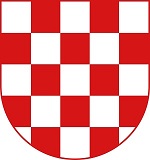 |
|
|
|
|
|
The truth about the victims : serbian četniks and jugo-serbian partisans kills 1.230.000 Croats and 140.000 Germans!
|
|
|
|
The anti-croatian elements like "historian"-slaves of the so called Serbs like Markovina, Jakovina, Goldstein, Srboje Klasić and yugo-friendly Faculties of Philosophy in Zagreb, Osijek, Rijeka or Split repeat the mythomaniac yugo-serbian and cetnik lies and fantasies about Serbian "victims" in the Independent State of Croatia.
They "forgot" always the Population census in the serbian dominated Kingdom Jugoslavia before WW II in the year 1931 and the serbian-dominated communisic Jugoskavia after WW II in the year 1948.
The Population census says that in the year 1931 in this country has lived 6.085.428 Croats and 6.758.499 Serbs.
The Population census says that in the year 1948 in this country has lived 5.199.770 Croats and 7.783.046 Serbs
>>> That means 884,712 fewer Croats, and almost a million more Serbs.
It should also be noted that the 1931 list does not include Croats from Istria (except for part of the Kastav municipality), the city of Zadar, the islands of Cres and Lošinj, Lastovo and Palagruža, and the city of Rijeka. These territories were given to the Italians by the Serbian Minister of Foreign Affairs Pašić in the Kingdom of Yugoslavia in the Treaty of Rapallo, which was signed by representatives of the Kingdom of Serbs, Croats, Slovenes and Italians on November 12, 1920.
It is estimated that around 350,000 Croats lived in these Croatian territories gifted by the Kingdom of Yugoslavia to the Kingdom of Italy.
This means that to the number of 884,712 missing Croats, those 350,000 Croats must be added.
>>> The final number of Croats missing between the 1931 and 1948 censuses is approximately 1,230,000 Croats fewer and 1,024,547 Serbs more!
According to German data, 150,000 Germans lived in the territory of the Independent State of Croatia in May 1941. After World War II, barely 10,000 Germans remained.
Since the Germans in the Independent State of Croatia were citizens of the Independent State of Croatia, the number of the German national minority in the Independent State of Croatia must be added to the Croatian victims of the yugo-serbian terror and occupation.
This means that during the Partisan and Chetnik terror in the Independent State of Croatia and the occupation of the Independent State of Croatia by the Yugo-Serbs, the number of Croatian and German victims was 1,370,000!
And now Markovina, Jakovina, Goldschwein, Srboje Klasić, ... ? Your Serbian masters themselves confirm the yugo-serbian lie of todays with their own numbers!!!
Why don't you believe THESE serbian numbers? Well, it's obvious, because this numbers don´t confirm the mythomanic number of 700,000 - 1,700,000 "serbian victims” in the Independent State of Croatia which you and your serbian masters lies since the end of WW II.
Official statistics from the Kingdom of Yugoslavia and its successor, the communistic Yugoslavia, prove the following :
In the period from 1921 to 1991, the number of Serbs in "Central Serbia" (i.e., Serbia without the provinces) increased by over 100% (from 2,531,321 to 5,081,766).
At the same time, in this demographically very short period of 70 years, the number of Serbs in Yugoslavia increased by a fantastic 86.17% (in absolute numbers, from 4,580,775 to 8,528,047).
The number of Serbs in the observed period, in almost all other republics and provinces, also increased drastically. In Bosnia and Herzegovina, which seceded from Croatia, by 65%, in Montenegro by as much as 963%, in Vojvodina by 122%, in Macedonia by 251%, in Slovenia by 715%, in Kosovo by 235%, and decreased only in Croatia, by 1.5% - which in absolute terms amounts to only 218, (despite the war and the mass abandonment of certain parts of Croatia during the colonization of Vojvodina, etc.)
(Source of data: Dr. Stanko Žuljić, Serbian Ethnology and Greater Serbianism, Zagreb, 1997, p. 166, table 14).
|
|
|
|

|
For four and a half decades, Serbo-communist propaganda constantly and aggressively pierced the ears of Croats with tirades about alleged Ustasha crimes, which were magnified at least twenty-fold, with the deliberate aim of imposing an inferiority complex, alleged genocide and guilt on the Croatian people. And not a single word could be heard from the Yugoslav communist side about the numerous crimes against Croats committed by the Chetnik and Communist side during 1941, nor about the causes of the Ustasha reprisals, which were the fruit of continuous Serbian crimes against Croats: from the crimes in Odessa in the summer of 1917, to the Serbian crimes in the April War of 1941.
Even before the beginning of the April War, the Serbs were mercilessly killing Croats. Božo Raič from Osmanlija, near Kupres, was doing his military service in early 1941. When it was learned that his brother was an Ustasha emigrant, he was killed. The young, talented Croatian writer Ivo Kozarčanin was killed by a Serbian guard on the sidewalk in front of the barracks in Ilica, Zagreb, when he was returning home at night, on February 4, 1941. The following lost their lives at the hands of ordinary Serbian peasants and citizens: on February 13, 1941, Luka Kolak from Tihaljina (Herzegovina), a gunsmith in Kosovska Mitrovica, and in February 1941, Jerko Tolić from Puteševica, also a gunsmith serving in Serbia.
All Croatian victims who died in April 1941 were mostly civilians; a very small number died during the disarmament of the Yugoslav army, and the number of those killed in direct armed combat was almost negligible.
Many Croats were killed before April 10, 1941, before the Croatian state was proclaimed, and while Dr. Vladko Maček, as the legitimate representative of the Croatian people, was a loyal member of the Yugoslav government.
|
|
|
|
|
|
The above just goes to show that the Serbian crimes of that time were committed out of Serbian hatred towards the Croatian people.
Until the end of April 1941, not a single Serbian civilian victim fell through Croatian fault, and only a few military personnel of Serbian nationality died, through their own fault during the rebellion in the Dinaric Division.
The Croatian people, therefore, did not provide any justifiable reasons for the Serbian crimes that were committed against them in April 1941 and that would continue with unabated ferocity, beginning not only until the end of 1941, but until the collapse of the Independent State of Croatia, and especially in the horrific aftermath of World War II.
Very extensive data on Croatian civilian victims in April 1941 is provided by Ivan Gabelica in his book Blaženi Alojzije Stepinac i hrvatska država (Zagreb, 2008).
Let us repeat or add to this: on an unspecified date in April 1941, the following were killed by Serbian hands: in Kosovo, Mitar Dubelj from Kijevo Dol, near Ravno; on the Arslanagića bridge, near Trebinje, Ivan Štironja from Aladinić near Stolac, Niko Goluža from Rotimlje near Stolac and Andrija Raguž Gunjinović from Stolac. On April 14, 1941, the Yugoslav authorities killed Ferdinand Petrilić from Stolac, who was serving in the army as a reserve officer in Jajce. A fatal accident also befell Vida Raguž Marijanović from Stolac, who was serving in the Yugoslav army as a reserve officer in Trebinje. In April 1941, he was found dead in the Trebišnjica River. While attempting to escape from the Yugoslav army, on April 4, 1941, Ivan Zelić, a native of Teskera near Ljubuški, was killed in the vicinity of Lake Skadar. Franjo Dodig from Zvirić near Ljubuški was also killed as a soldier during the April War of 1941 by the criminal hand of the serbian Chetniks. Soldier Ante Mišetić, a native of Grabovnik near Ljubuški, was killed near Shkodra on April 14, 1941. In April 1941, the Chetniks arrested, tortured and killed Nikola Jelčić from Stubica near Ljubuški in Goražde. Also in April 1941, the Chetniks brutally murdered Filip Ereš, a Yugoslav soldier, a native of Radišić near Ljubuški, in Montenegro. On the Albanian border, while attempting to escape from the Yugoslav army, Mijo Gadže, a native of Hardomilje near Ljubuški, was killed on April 14, 1941. In Montenegro, two Croats from Hardomilje near Ljubuški were killed by Chetniks: on an unspecified date in April 1941, Jozo Kravić was killed, and on April 10, 1941, Pero Boras was murdered.
On the orders of the Serbian criminal Bajo Stanišić, on April 13, 1941, near the Petrovići railway station, which was located in Montenegro, right next to the border with Herzegovina, all Croats - members of the local infantry regiment - were killed. In those days, Italian officers near Shkodra found the bodies of two murdered Croats: Ilija Delić and a Croatian soldier of unknown identity. The Italians found Croatian tricolors in the pockets of the deceased. During April 1941, in other places in the Kingdom of Yugoslavia, the following Croats, previously forcibly recruited into the Serbian army, lost their lives as unidentified Serb criminals: Petar Jukić "Kičić" from Runovići near Imotski, Jure Prusac "Juka" from Podrujnica near Metković, Petar Jerković from Krvavac near Metković and Petar Jerković, also from Kula Norinska near Metković. In Mostar, on April 13, 1941, a Montenegrin, a lieutenant in the Yugoslav army, fired three self-inflicted bullets at Sergeant Tikveš. Tikveš was left dead on the street because of his refusal to serve in the Greater Serbian army and his personal sympathies for the newly proclaimed Independent State of Croatia. Benjamin Petrinov, a native of the island of Ugljan, was shot dead by the Serbs on April 14, 1941, in Golubić near Knin, as a fugitive Croatian soldier, his heart was taken out with a bayonet, dismembered and then buried. In a similarly gruesome manner, while returning home from the disintegrating army, the Croat Nikola Došen, a native of the Gospić area, was killed in Divoselo in April 1941, when he was arrested by local Serbs and, after brutal torture, murdered. In the vicinity of Knin, in April 1941, Chetniks killed a demobilized Yugoslav soldier, a Croat named Milan Lapić, born in the Sinj area. On a train, near Knin, in April 1941, a demobilized Croatian soldier named Jure Franić, born in the Gračac area, was killed by Chetniks during an attack on the train. Corporal Jovo Bulajić, a Serb from the Podravska Slatina area, in April 1941, a few days after the proclamation of the Independent State of Croatia, killed cook Jozefina Plavšek and sergeant Mate Majetić while on duty at the police station. The aforementioned crime occurred in Tiškovec near Donji Lapac.
While protecting the bridges on the Drava from Chetnik destruction, in a conflict with the Chetniks in Osijek and in Tenja and Čepin near Osijek, on 10 and 11 April 1941, the following brave men died on the spot : Ivan Balaž, Miroslav Exinger and Zvonimir Bunek. On the same occasion, the following Croats were mortally wounded : Ivan Angebrandt, Marko Marić and Ivan Ribarić. In Ludbreg, on 10 April 1941, Serbian soldiers killed Pavle Fotak while destroying the bridge over the Bednja River. The day before, on 9 April 1941, Đuro Nožar and Petar Ciganović were killed in the defense of Virje near Đurđevac from an attack by serbian Chetniks. Jozo Marić and three other Croats were killed by Serbian soldiers in Bosanski Brod on 11 April 1941. On the same date, in Banja Luka, the Chetniks killed the worker Salih Gazić.
Serbian members of the Yugoslav Royal Army, in alliance with the Chetniks, during the April War of 1941, killed seventy Croats in Macedonia and Serbia : officers, non-commissioned officers and soldiers. In the period from 7 to 14 April 1941, dozens and dozens of innocent Croats were brutally murdered by the criminal Chetniks : in the vicinity of Bjelovar, Doboj, Srijemska Mitrovica and especially in the villages around Mostar and Čapljina, when, in addition to merciless murders, Croatian houses were burned. For example, on 8 April 1941, Serbian gunmen in Bjelovar killed Ivan Haniš and another soldier of unknown name, and seriously wounded three others, arrested them, beat them with rifle butts and ultimately left them without medical assistance. On the same day, the Margaretić brothers, in Gudovac near Bjelovar, killed two Croatian soldiers who were returning home in the 8th. On Mount Prolog, on April 10, 1941, Dr. Milan Luetić was killed. Two days before that, on April 8, 1941, forester Despinić, with twenty Chetniks, attacked the Croatian guards, killing many Croats, as well as almost all of the Chetnik attackers. The next day, on April 9, 1941, on the outskirts of Bjelovar, Serbian officers on guard killed Đuro Matijašić and a young high school student Milan Baćani. At the same time, Chetniks and Serbian soldiers committed terrible crimes against the unarmed Croatian population of Bjelovar and the surrounding area.
|
|
|
|
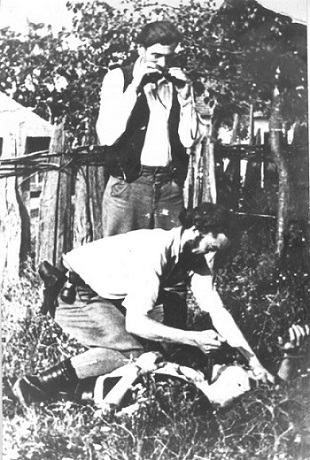
|
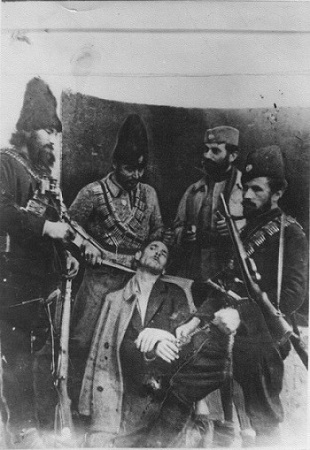
|
The general public is particularly concerned with the massacre of eleven Croatian peasants on April 10, 1941, in the Bjelovar villages of Kapeli and Donji, Srednji and Gornji Mosti.
According to data from the Bjelovar City Police Headquarters, which it submitted to the Ministry of Foreign Affairs of the Independent State of Croatia on April 30, 1941, in the Bjelovar area from April 9 to 29, 1941, twenty-eight people were killed by serb hands, all but two of whom were listed by name and surname.
However, this list is incomplete and inaccurate in some details. Namely, Ivan Haniš and his comrade were not killed on April 9, but on April 8, 1941, and the following victims of serbian crimes, military personnel, were omitted from the aforementioned police list : Milan Devčić (killed on April 8, 1941), Vjenceslav Pohunek (died seriously wounded on April 10 in the Bjelovar hospital), Ivan Novaček (died seriously wounded on April 14 in the Bjelovar hospital), Dragutin Farkaš and Dragutin Torkoš (both seriously wounded and died on April 23, 1941 in the Bjelovar hospital).
In addition, the list of massacred peasants in Kapela and Mosti is not complete, because two victims of serbian crime are omitted from the list : Ivan Blažeković and Stjepan Ružman. On April 9, 1941, in Rovišće near Bjelovar, serbian soldiers killed Milica Prelec. The next day, April 9, 1941, Chetniks murdered Melkior Novak in the Bedenik forest, and on April 25, 1941, Stjepan Žegarac was killed in Pavlovac, also near Bjelovar. .
|
|
Above :
Chetnik monsters are slaughtering Croats.
|
Above :
Chetnik monsters are preparing to slaughter a Croat.
|
|
|
|
|
|
|
On April 9, 1941, in the village of Kapela near Bjelovar, serbian Lieutenant Hergović committed a merciless, gruesome crime, cutting open the intestines of a Croatian peasant woman, Manda Filipović, and removing a six-month-old child from her
By the end of April 1941, serbian soldiers and Chetniks had murdered around forty people in the Bjelovar area alone, and as research continues, the number of victims of serbian crimes could be even higher.
|
|
|
|
In a clash with serbian soldiers, on April 10, 1941, Josip Burazin, Ivan Šamija and Marko Burazin were killed, and on the same date in Crikvenica, three officers of the Yugoslav Royal Army killed Petar Kvaternik (brother of Slavko Kvaternik) and reserve lieutenant Slavko Pipinić, and wounded Josip Car.
On the same day in Srijemska Mitrovica, the Chetniks removed the heart of a Croatian worker, Ivan Rajnović, in front of his mother. They then planned to shoot another dozen Croats and the local priest, Dr. Franjo Rački.
Well, they were saved from death by the Chetniks' flight due to the sudden arrival of the Germans. The Chetniks also killed several Croatian soldiers in Zagreb itself, on April 10, 1941!
In Mostar, on April 11, 1941, along with several other Croatian patriots, Zvonko Primorac was killed by serbian criminals. On the same date, along with several other Croatian patriots, Alija Salihkadić was killed in a clash with the Chetniks in Doboj. Even more horrific days followed in Herzegovina, when Chetnik units of the Yugoslav Royal Army attacked the Croatian population in Čapljina and the surrounding area of ??Mostar (the villages of Cim and Iliće), invariably destroying Croatian homes and farm buildings with cannon fire and incendiary bombs. At the same time, they slaughtered the Croatian population, who had not managed to escape the Chetnik knife. Eighty-five Croatian homes were set on fire. With the Chetnik slogan : - Slaughter everyone in order! - the half of the bloody Chetnik feast was twenty-five murdered Croats, including the entire families of Marko and Frano Vega from Struga, including helpless children. In addition to them, between 11 and 15 April 1941, Chetniks and serbian soldiers in Mostar and the surrounding area killed : Jure Zelenika, Stanko Lasić, Ivan Cvitković, Luca Mustapić, Zejna Duranović and her son, and Ivan Bevanda. Defending Stolac from the Chetniks, on 14 April 1941, Stanko Šutalo and Petar Štavun were killed. During the fighting around Stolac, the Chetniks killed Ibro Hasić while he was guarding cattle. Already at the beginning of the April War, the Chetniks killed Stjepan Perić in the Stolac area. On the road between Nevesinje and Gacko, the Serbs shot Mujo Bauk with a rifle on 24 April 1941 and then cut him into pieces with knives.
There are indisputable documents about the Chetnik crimes committed against the Croatian civilian population at that time, especially those disclosed in the ministry-book "Greueltaten und Verwüstungen der Aufrührer im Unabhängigen Staate Kroatien in den ersten Lebensmonaten des kroatischen Nationalstaates" ("Atrocities and devastation of the rebels in the Independent State of Croatia in the first months of the Croatian nation-state") and in the book "Documents on the Betrayal of Draža Mihailović" (Belgrade, 1946). In addition to the above, in "Glas Koncila", dated 15 June 1983, the then Bishop of Mostar-Duvno, Msgr. Dr. Petar Čule, stated: "The Serbs were the first to start digging pits in Herzegovina".
On April 12, 1941, Yugoslav aircraft attacked Donje Vinjane near Imotski with bombs. The following were killed : Ivan Bušić, Jakov Bušić (a nine-year-old child), Mate Bušić and Stipan Bušić. The next day, April 13, 1941, aircraft bombed Ljubuški and killed three civilians : Nikola Paradžik, Stanko Šarec and Stanko Vukojević. In a joint Serb-Chetnik attack from the ground and from the air, in April 1941, eight innocent people were killed in Požega : Jelka Slavina, Franjo Svoboda, Jozefina Svoboda, Marija Buček, Josip Svoboda, Venceslav Šmit, Mato Prepelac and Mate Prepelac's young son.
The April suffering did not spare Podravina either. According to the testimony of the local parish priest Mijo Jurić, in Peteranac near Koprivnica, on April 9, 1941, serbian Chetniks killed five people. On the same date, in other parts of Podravina, Ivan Hampovčan lost his life as a result of serbian crimes, the next day a young man and a girl in Virovitica and Julijana Horvat from Kozice lost their lives, and during the April War, Mijo Vujić also lost his life in the area of ??Podravska Slatina, Đuro Bušleta lost his life in the area of ??Orahovica, and as a result of his wounds near Varaždin, lawyer Dr. Aleksandar Belobrk died in a Zagreb hospital on April 17, 1941. Slavonia also had its victims in the April War. During the shelling and damage to the cathedral in Đakovo, on April 11, 1941, serbian soldiers killed : Pavle Jurković, Milan Labo, and two Croatian soldiers of unknown first and last names. In the vicinity of Srijemska Mitrovica, Lazar Barbasović was killed because, as an involuntarily recruited Yugoslav soldier, he refused to shoot unarmed people. The Serb Chetniks took hostages, taking doctor Dr. Pavle Löbl and municipal employee Mirko Vinković, along with several other Đakovo residents. It should be noted that the aforementioned crimes and the shelling of the Đakovo cathedral were committed by Serbs from Croatia!
Even before April 6, 1941, at the railway station in Velika Kapela, Serbs brutally murdered Stjepan Nikšić. Velika Kopanica near Slavonski Brod claimed four victims in the first days of the April War : Stjepan Vukovac was slaughtered on April 9, 1941, Stjepan Hradtman and Fabijan Vukovac were murdered on April 11, and Franjo Kablarić on April 12, 1941.
On April 11, 1941, the Serb Chetniks took twenty Croat hostages from Stari Mikanovaci near Vinkovci, and then shot them near Orašje, on the banks of the Sava River. They also shot four hostages from Vođinci near Vinkovci. In the village of Posavski Podgajci near Županja, on April 12, 1941, they shot : Marko Iskrić, Antun Lucić – Tadijanov, Marko Klarić, Ivo Petrović with his wife, Stipe Matić and Milan Petrović. Other villagers had to flee for their lives. Antun Šćuka, with the Croatian flag in his hand, was killed near Valpovo in a Serbian ambush on April 11, 1941. Pero Braun, near Županja, was shot by the Chetniks on April 10, 1941. In Srijemska Mitrovica, on April 11, 1941, besides the aforementioned carpenter Ivan Rajnović, the shop assistant Aleksandar Šimun, the peasant Mitar Marušić and the worker Vilim Červenjak were killed.
On the greatest Catholic holiday, Easter, on April 13, 1941, in Subotica, the Chetniks cowardly and cruelly killed the high school student Stjepan Tuša from an ambush.
|
|
|
|
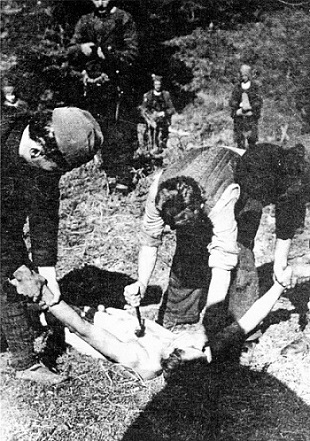
|
During the April War of 1941, Bosnian Posavina also suffered its victims. Derventa and its surroundings suffered the most. On April 12, 1941, serbian soldiers murdered : Peja Matijević, Jozo Krijan, Niko Princip, Jozo Kljajić, Mate Glavaš, Ilija Kozina and Anđa Sušić and her six-year-old daughter Anica. The next day, April 13, 1941, the Chetniks killed : Blaž Kovačević, Stipe Zirdum, Lucija Koljan and her mother Marija, the wife of Jakov Miloš from Derventa, Šima Markanović, and Anka Orozović. Jela Ravlić was mortally wounded by the Chetniks: she died after bleeding to death helplessly.
Two days earlier, on April 11, 1941, the Serbian captain Marušić put seven Croats in prison in Derventa, whom the Chetniks killed the next day. It is estimated that in the days after the proclamation of the Independent State of Croatia, at least twenty-five Croats, mostly civilians, were killed by the Serb Chetniks in Derventa and its surroundings. Even before that, in Bosanski Svilaj near Odžak, on April 9, 1941: the Serb Chetniks killed and mortally wounded eleven people. In Doboj, in those April days, Serbian soldiers killed three Croats: they gouged out the eyes of one, took out the heart of another, and cut open the cheek of a third and cut off his ears. According to the testimony of the Doboj parish priest, Dr. Dragutin Kamber, the Chetniks killed at least three more Croats in Doboj.
There were crimes in other parts of Bosnia as well. I will name a few. In April 1941, in the village of Kijevo near Sanski Most, the Chetniks killed four villagers; on April 14, 1941, Adem Selman in Kotor Varoš and the minor Mijo Blažević in Kiseljak. Ivan Bandić, from the Gornji Vakuf area, was gouged out by Chetniks during those days, then stabbed him in the throat and inflicted a total of thirty-three wounds, and the unfortunate man died in agony the next day.
The Serb Chetniks also showed their criminal face in Dalmatia during those days. Wherever they went, they looted, burned houses and took people's lives. Retreating from Benkovac towards Knin, Serbian soldiers, members of the Adriatic Division, murdered Marija Bukarica, a child of only six years old, as well as Marica Tomić and Boja Šiklić on April 12, 1941, in Siverić near Drniš. On the same day, they killed Lovro Čavčić, and the next day, April 13, on Easter, Serbian soldiers killed Josip Bojčić on the Drniš bridge. Mate Prnjak, a native of the Drniš area, was killed in an ambush by Chetniks near Knin on April 30, 1941, while he was carrying food to hungry children from Slavonia.
|
|
Above : Chetniks remove the heart from the chest of a still-living Croat.
|
|
|
|
|
|
|
In April 1941, in Prović near Benkovac, the Chetniks slaughtered Šima Klarić. On the Risovac mountain, on April 14, 1941, they killed Nikola Matić, a native of Vrpolje near Knin. During those days, they killed the aforementioned Benjamin Petrinov, and in the first days of the April War in 1941, Yugoslav gunmen killed Ivan Babić from Runović in an ambush near Imotski.
Also in April, the Chetniks killed the Croatian patriot Stanislav Polonij in Delnice, then in mid-April 1941 in Brod na Kupi in Gorski Kotar the Ustasha commissioner for Gorski Kotar, Ante Polonij, and towards the end of April of the same year in Dvor na Uni, Srećko Bogadi.
Near Blagaj in Herzegovina, on May 5, 1941, the Chetniks killed five Croats. The Chetniks and communists took the lead in the serbian rebellion against the young Croatian state. The said anti-Croatian groups of Chetniks and communists tried to organize themselves in all areas of the Independent State of Croatia where Serbs lived more compactly, and they linked up with each other. During May and June 1941, the Chetniks and communists intensified their attacks on the Croatian state and its unprotected assets, killing innocent civilians. The murder of five members of the Jose Mravunc family, including two minor children, was particularly shocking to the wider Croatian community at the time. The aforementioned crime took place in Hrvatski Blagaj near Slunj, on the night between 5 and 6 May 1941. As a prelude to the Serb uprising, in the village of Rankovici near Ljubinje, at the end of May 1941, Ustasha Halil Talsman was killed. In eastern Herzegovina, on 24 June 1941, the so-called Chetnik Vidovdan Uprising broke out, which, according to Serbian sources, resulted in one hundred and twenty-three dead and two hundred wounded Croatian soldiers. At the very beginning of the Vidovdan Uprising, the Chetniks killed all the Croats in the police stations : Jasenik, Stepen and Kozanci - in the Gacko district. The next day, 25 June 1941, the Chetniks killed nine Croatian police officers in the Lukavac police station near Nevesinje. Croatian armed forces liberated Nevesinje from the Chetniks on June 27, 1941, and on June 28, 1941, the Chetniks occupied Avtovac in eastern Herzegovina. There, after a three-day armed resistance, they slaughtered forty-seven Croats and burned down all the houses in Avtovac. The last day of June 1941 was also marked by Chetnik atrocities. Under the leadership of priest Momčilo Đujić, on June 30, 1941, the Chetniks killed more than a hundred Croats in the vicinity of Knin and Zadar, and on the same day they massacred Croats in Blažuj and in the districts of Derventa, Varcar Vakuf and Zvornik. On the same day, on Sjetina on Jahorina, under the leadership of Sava Derikonja, they slaughtered sixty-five civilians. In eastern Herzegovina, on July 17, 1941, the Chetniks again rebelled against the Independent State of Croatia and carried out massacres in the Ljubinje district, in the villages of Dječ, Orahovica, Fatnica, Bjelan, Sakotići and Plana. On the same day, the Chetniks carried out massacres in the Trebinje district, in the villages of Begovići, Gornji Turani, Donji Turani and Staro Slano. Then, on July 26, 1941, two thousand Chetniks, led by the infamous butcher Momčilo Đujić, carried out massacres in the vicinity of Knin, in Donji Ervenik (thirty Croats slaughtered!) and in Golubići, Ugarci and Komite. On the same date, in the Bosansko Grahovo district, the Chetniks carried out massacres in the villages of Sarići, Špiranovići, Čuline and Kardumi and, under the leadership of Duke Zlovođe, slaughtered twenty-one Croats.
The first Catholic priest to be killed in the Independent State of Croatia was Waldemar Maksimilijan Nestor. As a priest of the Banja Luka Diocese, he served as the parish priest in Drvar. As the parish priest of Drvar, he received an invitation to preach and celebrate Holy Mass on Saturday, July 26, 1941, on the feast of St. Anne, in Kosovo near Knin. Therefore, he went there on a pilgrimage with a large group of his parishioners. After the rites were completed, the Knin friars advised him not to return to Drvar because of the Chetnik rebellion. However, the parish priest did not want to leave his parishioners for Sunday Holy Mass, so he took an early morning train back to Drvar. On the way back, the Chetniks intercepted the train, captured three hundred and fifty pilgrims and the parish priest of Drvar, tied them up, and on July 27, 1941, killed them near the Golubnjača pit and threw them into the pit. On the same day, another Catholic priest was killed by the same bandits: Juraj Gospodnetić, a priest of the Banja Luka diocese and parish priest in Bosanski Grahovo. After arresting him, the Chetniks led him tied up around Grahovo on a bear's back, brutally massacred him, and tortured him to death by impaling him and roasting him on a spit. His final resting place is unknown, but it is known that the so-called anti-fascists still celebrate that day as "the day of the uprising" that began with the mass murders of Croats and Catholic priests in Drvar and Bosanski Grahovo. On that same ill-fated July 27, 1941, the Chetniks also started a new Serbian uprising in the area around Donji Lapac. The uprising was organized by the Chetniks and communists on July 27, 1941, and was led by prominent partisan officials, along with the Chetniks: Đoko Jovanić, Gojko Polovina, Stojan Matić, and other communists.
|
|
|
|
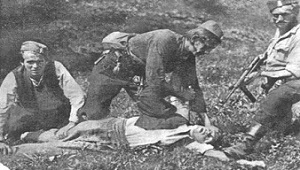
|
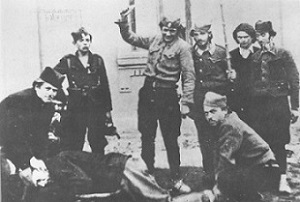
|
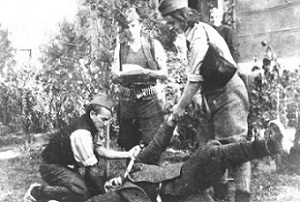
|
|
Above : Chetnik monsters are slaughtering a Croat.
|
Above : Chetnik Balkan nomads slaughter a Croat.
|
Above : Chetnik monsters behead a living Croat.
|
|
|
|
|
|
In the areas affected by the rebellion, which were areas where Serbs lived more densely, the Croatian population was almost completely exterminated or expelled. Several thousand civilians were killed, and after these crimes, the Chetniks and Partisans concluded an agreement on October 1, 1941, according to which they established a joint Chetnik-Partisan military headquarters. The agreement was signed on the Chetnik side by Jezdimir Dangić, Sergije Mihailović and Pero Đukanović. The signatories on behalf of the Partisans were: Rodoljub Čolaković, Slobodan Princip and Svetozar Vukmanović. Even before this inter-Serbian agreement, the heinous crimes against Croats did not abate. On the contrary! On July 30, 1941, the Chetniks slaughtered thirteen captured Home Guardsmen in Plana, and carried out massacres in western Bosnia, causing the following places to suffer: Oblaj, Veliki Sarići, Mali Sarići, Mandići, Korita and Žulji. Fifty-one Croats were thrown into deep pits. Two days before the Assumption, on August 13, 1941, the Chetniks killed about a thousand civilians in the Vlasenica district, burning the villages of Močila, Mala Baklela, Begovići, Borojevići, Tarići and other villages; then they killed the entire population of the village of Milići; then in the Trebinje district, in Stari Slano, they slaughtered one hundred and thirty Croats and burned seventy-three houses; in Dieč near Bileća they killed seventy people and one hundred civilians in Orahovica. On the same day, the following suffered severely: Sakotići, Prisoj, Bjelan and Fatnica. In Voletovo, the Chetniks killed thirty-eight gunmen, and in Plana, forty-two peasants were thrown into a pit. In Krupa, on the same date, the combined Chetnik-Partisan bandits killed thirty Croats and in Krnjeuša, Vrtoče, Lastva and Zelinovac two hundred civilians and burned more than one hundred and fifty Croatian homes. At that time, the parish priest in Krnjeuša, Krešimir Barišić, was scalped and thrown into a burning church. On the same day, mass massacres of civilians were carried out in Prijedor and in the villages of: Tavija, Begović Kula, Nikontovići, Glavinići, Lomača, Gornji Turani, Donji Turani and Sarana. Then, on November 6, 1941, the Chetniks crucified Jur Mladin, the parish priest in Zastok, alive on a tree and removed his body three days later.
In the Rogatica district, on November 25, 1941, the Chetniks burned seventy-one villages to the ground and slaughtered three hundred wounded and sick people in the Rogatica hospital. On November 30, 1941, the Chetniks killed all the inhabitants of Međeđa, in eastern Bosnia; in Koritnik, they scalped twenty people; many of the slaughtered civilians were thrown into the cold Drina River; in Komaj near Bijela, they burned down one hundred and fifty houses and killed three hundred people; in Tuholj, they slaughtered twenty-two civilians. On Christmas Day 1941, the Chetniks began horrific massacres in the Foča and Goražde districts, the number of victims of which was seven thousand.
The continuous Serbian crimes, as I have already emphasized, during the existence of the Greater Serbian Kingdom of SHS and the Kingdom of Yugoslavia against the Croatian people continued in 1941, immediately after the proclamation of the Independent State of Croatia. A similar criminal scenario would occur half a century later in the Homeland War! Previous Serbian crimes shortly after the establishment of the Independent State of Croatia (more than three hundred Croats killed!) provoked unbridled retaliation from the Croatian side.
The first such reprisal took place in Gudovac near Bjelovar on April 28, 1941, when the first civilian Serb victims fell. The Croatian reprisal, which certain quasi-historians exaggerate and use today for political purposes, was condemned at the time by the Archbishop of Zagreb, Dr. Alojzije Stepinac. The Croatian revenge taken for the Serbian crimes, which were first committed in Bjelovar, and which, for example, provoked an Ustasha revenge - was not directly based on any legal provision of the Independent State of Croatia. The state leadership of the Independent State of Croatia from the beginning tried to prevent any arbitrariness in accordance with the law. This is supported by the Poglavnik's legal provision of June 26, 1941, which stipulates that "anyone who at any time commits any violence against the life or property of any citizen or member of the Independent State of Croatia will be brought before a direct court, and any member of an Ustasha organization or soldier who is guilty of such a punishable act will be immediately shot by an Ustasha court." The aforementioned legal provision did not remain a dead letter of the law on paper. In fact, the following Ustasha or "wild Ustasha" were shot by the Croatian authorities of the time on the basis of convictions of direct or mobile direct courts for crimes committed against Serbs: on August 19, 1941 in Sarajevo, Tomo Mileusnić, Janko Ivanković, Ivica Lončarić and Matija Tadić; on September 3, 1941 in Zagreb, Eugen Guić; On September 21, 1941, in Zagreb, Smajil Jusić and Ivan Gržanić; on September 26, 1941, in Mostar, Pero Pažin and Meho Zulić; in the fall of 1942, in eastern Bosnia, Warrant Officer Žižanović; on November 13, 1942, in Sarajevo, Ante Delić and Marko Tomić; in Gospić, Ustaše Frković and Pavletić were hanged for the rapacious murder of two old Serbian women, the Lemaić sisters; in Zagreb, Zvonko Devčić, an employee of the UNS, was shot for the murder of a Jewish couple out of greed. And his uncles, participants in the Velebit Uprising; old Ustaše from the first emigration, knight Kruno Devčić and major Ivan Devčić Pivac - did not even want to visit him in prison because of his shameful act, let alone take action to save him from a deserved execution.
|
|
|
|
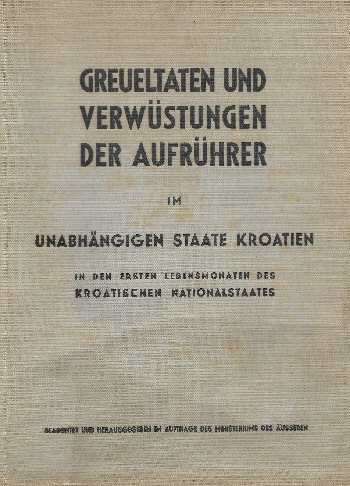
|
Book : "Greueltaten und Verwüstungen der Aufrührer im Unabhängigen Staate Kroatien in den ersten Lebensmonaten des kroatischen Nationalstaates" ("Atrocities and devastation of the rebels in the Independent State of Croatia in the first months of the Croatian nation-state").
One of the most expensive and rarest books from the Independent State of Croatia era (left) is a book in german language that testifies to the destruction and atrocities of the rebels from April 13, 1941 to October 1942.
It distinguishes the following rebel formations:
- Chetniks
- Chetnik communists (Chetniks who converted to partisans during the war)
- Communists / partisans (Communists / partisans were founded in Serbia by the Chetniks, as the red (communist) faction of the Greater Serbian Chetniks.)
The book "Greueltaten und Verwüstungen der Aufrührer im Unabhängigen Staate Kroatien in den ersten Lebensmonaten des kroatischen Nationalstaates" was published by order of the Ministry of Foreign Affairs in 1942.
The name of the book translated into English is: "Atrocities and devastation of the rebels in the Independent State of Croatia in the first months of the Croatian nation-state".
|
|
|
|
|
|
Chronology of Chetnik, Partisan and Serbo-Communist crimes in the Independent State of Croatia from April 1941 to October 1942 :
- 13, 14 and 15 April 1941 : killing of Croats in Čapljina and the surrounding area.
- 15 April 1941 : Chetnik destruction and killing of Croats in the villages of Ilići and Cim near Mostar.
- April 1941 and the following months : rampages, destruction and killing of Croats in Gornji Evernik, Obljaj, Ugarci, Luka, Korito, Stikovo and Vrlike.
- April 1941 to 31 December 1941 : killing of Catholic and Muslim Croats in the villages of Varcar-Vakuf, Draganić, Trnovo, Bistovica.
- 5 May 1941 : Chetnik communists kill the Croatian family Mravunac in Blagaj.
- 28 June 1941 : Chetnik destruction and killing of Croats in the village of Avtovac near Gacko.
- July 9, 1941 : Unprecedented atrocities by Chetnik-Communists in the villages of Kljenak and Vrieka near Stolac.
- July 27, 1941 : Massacre of Croats in Bosanski Grahovo.
- July 27, 1941 : Massacre of Croats in Drvar.
- August 1, 1941 : Chetnik-Communists kill Croats near Knin.
- August 2, 1941 : Chetniks and Communists completely destroy the village of Boričevac.
- August 7, 1941 : Burning of Croatian villages near Trebinje.
- August 9 and 10, 1941 : Horrible Chetnik bloodshed in the villages of Krnjeuša and Vrtoče.
- August 12, 1941 : Brutal killings of Croats in the villages of Draganić and Pliva.
- August 12, 1941 : Chetniks burn Croatian houses near Bosanska Kostajnica.
- August 18, 1941 : Bloody days in Srebrenica and the surrounding area at the hands of Chetnik communists.
- August 21, 1941 : Chetnik communists burn the Croatian villages of Močile, Radić Mali, Borojevići, Tadići and Begovići.
- August 28, 1941 : Chetnik communists attack and occupy the village of Plana and kill all Croatian Home Guards.
- September 15, 1941 : Chetnik atrocities near Glina.
- September 28, 1941 : Chetnik communists kill German families in the town of Krčedin.
- October 20, 1941 : Chetnik communists attack the village of Polje near Otočac.
- October 23, 1941 : Chetnik massacre in Kulen Vakuf.
- October 29, 1941 : Chetnik massacre of Muslim Croats in the village of Bileće.
- October 29, 1941 : Chetnik communists kills Croats near Trebinje.
- November 4, 1941 : Chetniks kill Croatian Muslims in the villages of Prača, Lunje, Sočice and Modrik.
- November 13, 1941 : Chetnik communists go on a rampage and cut off the breasts of Croatian women in the village of Međeđa.
- November 28, 1941 : Total destruction of the Croatian Muslim village of Koraj by the Chetniks.
- December 9, 1941 : Chetnik communists kill Croats in Foča.
- December 12, 1941 : Killing of Muslim Croats near the village of Jezersko.
- December 15, 1941 : massacre of Catholic nuns in Podrinje.
- December 31, 1941 : bloody Serbian massacre of Muslim Croats in Foča.
- December 31, 1941 : Chetniks kill Muslim Croats in the village of Tuholj near Kladanj.
- end of 1941 and during 1942 : Chetniks and partisans go on a rampage in Široka Kula.
- January 5, 1942 : destruction and burning of houses of Croatian Catholics and Muslims in the villages of Isakovci, Radaslije, Čolije, Odžak, Halapić, Mlinište, Mladašković and Opačić.
- January 16, 1942 : Chetnik massacre of Croatian Muslims in the villages of Ocrkavlje, Rataje, Mrežica and Jabuka.
- January 17, 1942 : atrocities against Croatian Muslims in the village of Koritnik.
- January 22, 1942 : Chetnik communists destroy and kill in the vicinity of Glamoč.
- January 26, 1942 : Chetnik communists slaughter Croatian Muslims on the Drina bridge in Goražde and loot their houses.
- February 2, 1942 : Chetnik communists kills children in the village of Plošnik near Rogatica.
- February 8, 1942 : Chetnik communists unleash a savage attack on the vicinity of Čajniče.
- May 15 and 16, 1942 to June 10, 1942: hundreds of Croats are killed and tortured by Chetniks in Priedor and the surrounding area.
- March 25, 1942 : Chetnik communists commit bloodshed in the villages of Bukvica and Golubići.
- March 29, 1942 : Chetnik communists kill thousands of Croats near Višegrad.
- June 15, 1942 : Chetnik atrocities against Muslim Croats in the vicinity of Lubinja.
- July 22, 1942 : Chetnik communists kill about 300 Croats in Drvar.
- August 29, 1942 : Chetnik massacre of Croats in the villages of Zabiokovlje, Dragljane and Kozica.
- August 29, 1942 : Chetnik massacre of Croats in the village of Vrgorac.
- October 1, 1942 : Chetnik massacre of Croats in the villages of Gata, Čišli, Zvečanja and Ostrvici.
- October 1942 : Chetniks and Italians kills Catholic and Muslim Croats in Rama.
|
|
|
|
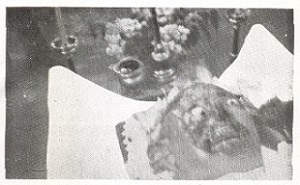
|
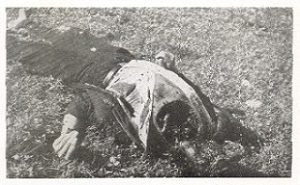
|
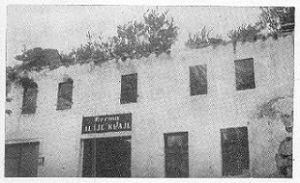
|
|
Priest Jakob Barišić.
The Chetniks peeled the skin off his head.
|
Chetniks attacked a Croatian Muslim, Salko Mimeš, on the road to Prijedor and beheaded him.
|
The Chetniks burned down all the houses of the Croatian peasants in the village of Ilići.
The picture shows the burned house of Ilija Kljaj in Ilići.
|
|
|
|
|
|
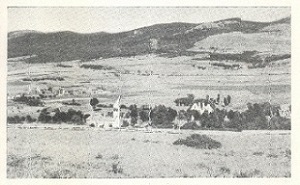
|
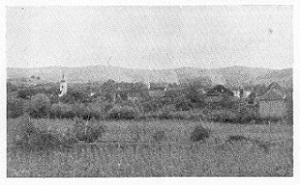
|
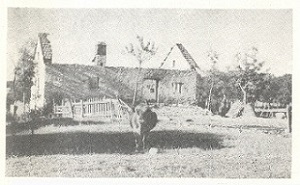
|
|
View of the burned village of Krnjeuša.
|
Chetniks burned down the houses of Croatian Catholics and Croatian Muslims in Bosanska Kostajnica.
|
The Chetniks burned down the entire village of Zelinovac.
The picture shows one of the burned houses.
|
|
|
|
|
|
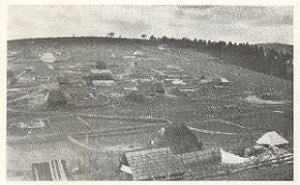
|
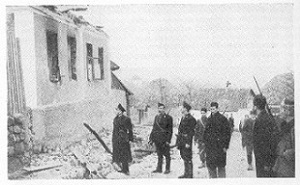
|
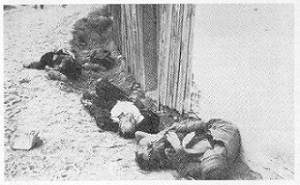
|
|
It was the Croatian village of Žljebovi.
The Chetniks completely destroyed the village.
|
The village of Koraj after the Chetniks destroyed the entire village.
|
Četnici su ubili u selu Koraj i ovo petero hrvatske djece muslimanske vjere.
|
|
|
|
|
|
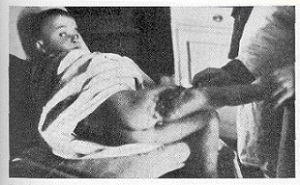
|
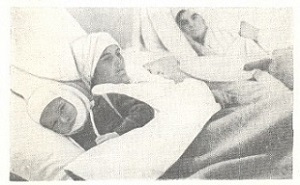
|
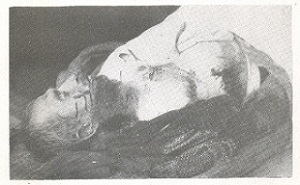
|
|
Chetniks mutilated and injured children like this boy in Goražde.
|
Survivors of the Chetnik attack on the village of Koraj in the hospital in Tuzla.
|
Croat Mijo Bauk from the village of Ravni Kotar near Gacko, killed in September 1942 on the road from Nevesinje to Gacko.
Before he was killed by the serbian Chetniks, he was tortured terribly. The Chetniks peeled off the skin from the lower part of his face.
|
|
|
|
|
|
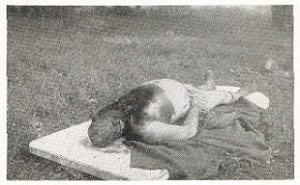
|
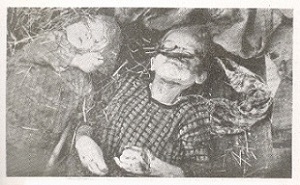
|
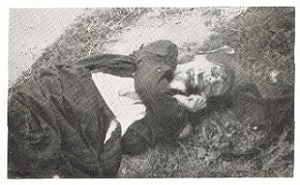
|
|
On August 25, 1941, Chetniks killed Ljudevit Draskler from Teslić in the Borja forest (between Teslić and Banja Luka). They took his heart out of his chest and peeled the skin from his head to half of his chest.
His body was found in this condition two days later.
|
Two children killed by serbian Chetniks in the village of Košutica.
|
A Croatian peasant woman from the area of ?Gradačac, killed by partisans.
|
|
|
|
|
|
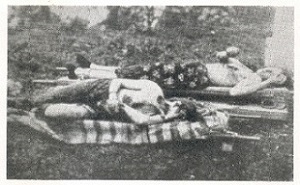
|
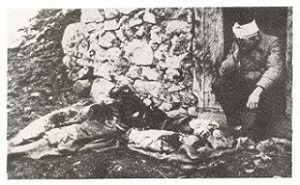
|
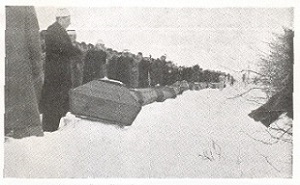
|
|
In the village of Međeđa after an attack by serbian Chetniks and communist gangs. The wife of Ibrahim Kos and Čanka Murtić were tortured terribly. Before they were killed, the women's breasts were cut off. This happened on November 2, 1941.
|
When he returned to the village of Košutica on February
27, 1942 with the Croatian Home Guard, he found his entire family killed by Chetniks in front of his house.
|
Croatian Muslims at the burial of the victims of the Chetnik attack on a train near Priedor.
|
|
|
|
|
|
|
|
Stamps of the croatian emigration : Beware of the Yugoslavs! Buy here : 
|
|
|
|
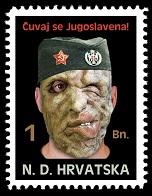
|
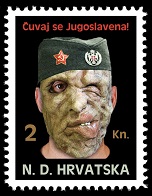
|
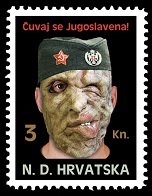
|
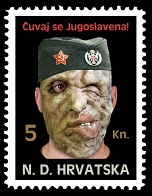
|
The stamp-set contains stamps of 1, 2, 3 and 5 Banica and 1, 2, 3 and 5 Kuna.
Day of issue : 10.4.2024.
|
|
|
|
|
|
|
|
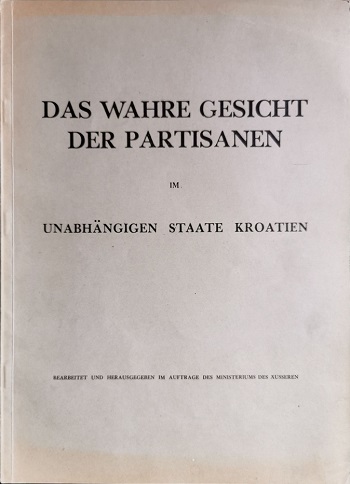
|
Book : "Istinito lice partizana u Nezavisnoj Državi Hrvatskoj" ("The True Face of the Partisans in the Independent State of Croatia").
The book "Das wahre Gesicht der Partisanen im Unabhängigen Staate Kroatien" ("The True Face of the Partisans in the Independent State of Croatia") was written by the German Ernest Bauer in 1943 and deals with the crimes of the serbian Chetniks, serbian Chetnik-communists and Partisans from October 1942 to 1943 and was published by order of the Ministry of Foreign Affairs.
The first book "Greueltaten und Verwüstungen der Aufrührer im Unabhängigen Staate Kroatien in den ersten Lebensmonaten des kroatischen Nationalstaates" ("Atrocities and Destruction of the Rebels in the Independent State of Croatia") is optically very similar, so it is assumed that it was also written by the German Ernest Bauer.
"Greueltaten und Verwüstungen der Aufrührer im Unabhängigen Staate Kroatien in den ersten Lebensmonaten des kroatischen Nationalstaates" can be found with good luck in German antique shops for around €1,000 - €2,000.
"Das wahre Gesicht der Partisanen im Unabhängigen Staate Kroatien" is a bit cheaper, between €350 - €550.
|
|
|
|
|
|
Philatelic issue of the German military association “Handschar” (“Handžar”) : Beware of Chetnik and Partisan bandits. Buy here : 
|
|
|
|

|
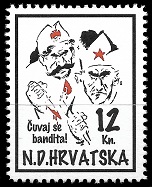
|
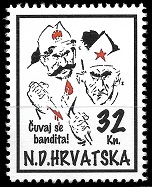
|
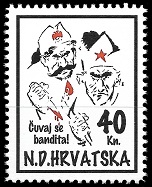
|
The series consists of stamps of 10 Banica, 25 Banica, 50 Banica,
75 Banica, 2 Kuna, 3 Kuna, 5 Kuna, 8 Kuna, 10 Kuna, 12 Kuna,
20 Kuna, 25 Kuna, 30 Kuna, 32 Kuna, 40 Kuna and 50 Kuna.
Date of issue: 10.4.1990.
|
|
|
|
|
|
Both the first and second Yugoslavias were and remain a prison and a tomb for Croats – and only Croatian “leftists” do not notice and persistently ignore this. In 1910, when the last census was taken on the eve of the Great War of 1914-1918, many areas in Croatia, Bosnia and Herzegovina, eastern Srijem and Boka Kotorska were absolutely Croatian, but in the period from 1918-1991, during the time of both Yugoslavias, they were transformed into Serbian or Muslim ethnic areas. Croatian “leftists” do not want to see this, and the Serbian political elite, knowing all this, enjoys the fruits of the plunder of Croatian lands.
Specifically, in 1910 Petrovaradin had 95% Croats, and today, a little over a century later, two world wars and the aggression of Serbia against Croatia from 1991 to 1995, Petrovaradin has only about 7% Croats, while the number of Croats with a share of 35% in Srijemski Karlovci, or 40% in Srijemska Kamenica, dropped to 2%-3% in 105 years. In Srijemska Mitrovica, Ruma, Inđija, Šid and Zemun, there was an equal number of Croats and Serbs in 1910. In all these places there was also a relatively large number of Germans and Hungarians. In Zemun, Hungarians made up a relative majority with some 6600 inhabitants out of a total of 17000 people in the whole of Zemun.
There were 4400 Hungarians, 3300 Serbs, 2200 Croats. Today, Zemun has 95% Serbs. That says it all. Stara Pazova had an absolute majority of Slovakian evangelicals, and there were also Germans, Hungarians, and least of all Serbs. Today, 95% of Serbs are there. They expelled not only Germans after the Second World War, but also Hungarians and Slovaks, who fell from 75% of the population in 1910 to 3% of the population in 2015. Germans and Hungarians were expelled from Mitrovica, Inđija, Šid, Ruma, and in the 1990s Croats were also decimated.
In numbers, the greatest persecution was experienced by Croats in Šid, where until 1991 there were 7,000 Croats, and today only 2,000 Croats remain. Šid still had a slight Croat majority in 1939, and therefore, by the Cvjetković Maček agreement, it belonged to the Banovina of Croatia. Today, Šid has over 90% Serbs. In 1910, the entire eastern Srijem had 42% Orthodox Serbs, while the absolute majority of 58% was made up of Catholic peoples, Croats, Germans, Hungarians and Slovaks. Of the latter, there were also some Evangelicals in and around Stara Pazova.
Individually, Croats made up 25% of the total population, or 108,000, and Serbs 180,000. Today, only a few tens of thousands of Croats remain, and Germans, Hungarians and Slovaks are only in the category of statistical errors.
An even greater pogrom was suffered by Croats in the two Yugoslavias in Boka Kotorska, the bride of the Adriatic and the bay of Croatian saints. In 1910, the ratio of Catholic Croats to Orthodox Serbs and Montenegrins was 35% to 65%. But, although Croats were only slightly more than a third of the population, all the towns on the coast with the exception of Risan were ethnically Catholic and Croatian, and there were also Croatian settlements south of Boka Kotorska, such as Budva, Bar and Spiča (today Sutomore). Only Ulcinj was and remains purely Albanian.
A hundred years ago, Tivat was 95% Croats, Herceg Novi 70% Croats, Perast also 70% Croats, and Kotor a percentage point less, exactly 69% Croats. Budva had 82% Croats, Sutomore 90% Croats, and Bar 40% Croats. About 55% of the Baran people were of the Orthodox faith, which, according to the writings of academic Josip Pečarić, who hails from those regions and now lives in Zagreb, was converted to Orthodoxy in 1905 by the Montenegrin King Nikola with a decree that everyone had to "be baptized in the Orthodox church on the same day, in order to become Serbs of the Orthodox faith and receive new names and surnames."
Said and done, and so the Croatian city of Bar became a Serbian-Montenegrin port on the Adriatic back in 1905, when King Nikola and his army descended Mount Rumija, above the city, as described in detail by academic Josip Pečarić. Today, Tivat, with a 95% Croatian population, has decreased to 19% Croats in the city itself, while Kotor, with a 69% Croat share, has been reduced to 7.5% Croats. In Herceg Novi, there are 2.5-3% Croats, as well as in Bar. In Budva, from the former 82% Croats, there are now only 0.5-1% Croats in this “Serbian” tourist Mecca. Sutomore, with 90% Croats, has decreased to only 0.5% of the Croatian population in 105 years of persecution, assimilation and killing (which was the fate of all other places on the Montenegrin coast). How can all this be called anything other than ethnocide with a touch of memoricide of the people there who are denied the right to historical memory of their ancestors, let alone highlighting national characteristics, anytime and anywhere?!
A special chapter is the Croats in Bosnia and Herzegovina, which is the cradle of Croatian statehood and the core of the oldest Croatian kingdoms. Until the Turkish invasion and invasion of the Balkans, only Croats lived in Bosnia and Herzegovina. Today, the picture is completely different. There are far more Serbs and now newly formed Bosniaks - Muslims who denied their Croatian origin and ignored the fact that even before World War II in the Assembly of the SHS region, out of 24 representatives of the Muslim party from Bosnia, 21 declared that they declared themselves Croats of the Islamic faith.
Only two were undecided and only one said that he was a Turk. It was Mehmed Spaho, whose grandson followed in his grandfather's footsteps in Serbia in the 1990s, joining Šešelj's Radical Party and serving as their local representative in Loznica, where he lived at the time. Dr. Jakov Gel's book "Population of Bosnia and Herzegovina", published in April 1995 and stored at the Croatian Statistical Office (DZS), contains an overview of the rise and fall of the population of all three main religious and national communities in BiH from 1910 to 1991.
Data are also provided for the urban population of 30 representative cities in BiH in the period from 1910 to 1991.
In 1910, Croats had an absolute majority in Bosanski Brod of 58%, in Fojnica 52% Croats, in Jajce 53% Croats, Vareš 80% Croats and in Zavidovići 59% Croats. Relative Croat majorities were in Bugojno with 46% Croats, Kotor Varoš with 49% Croats, and Livno with 45% Croats. An interesting detail for Sarajevo, Zenica and Travnik is that they each had only one percentage point more Croats than Bosniak-Muslims. In Sarajevo, 34% of the population was Muslim, and 33% was Croat. In Sarajevo, Serbs made up only 16% of the total population. In Zenica, 40% were Croats and 41% were Muslims, and the same ratio of Catholics to Muslims was recorded in Travnik, i.e. 41% to 40% in favor of Muslims. There was also a significant influence of Croats in cities that had neither a Muslim nor a Serb majority. Thus, in Banja Luka, with a relative Muslim majority of 43%, there were also 28% Croats and 26% Serbs. In Bihać, there were 60% Muslims, but also 28% Croats and only 9% Serbs. In Doboj, Muslims formed an absolute majority of 52% of the population, followed by Croats with 32%, and Serbs were only 10% of the population. In Mostar, Muslims were 44%, Serbs 28%, and Croats 27% of the population. In Drvar, where on July 27, in a joint action by Partisans and Chetniks, 2,000 Croats were killed, as early as 1910 there were 40% Croats and about 58% Serbs. In Tuzla, there were 52% Muslims, 29% Croats, and 18% Serbs. In Trebinje, in addition to 42% Muslims and 39% Serbs, there were also 18% Croats. 10% of Croats lived in Goražde, and 12% of Croats in Bijeljina, although those three municipalities are considered traditionally non-Croatian territory, but old lists say something else.
Overall, of the 30 representative cities, Bosnian Muslims were a relative or absolute majority in Banja Luka, Bihać, Bijeljina (59%), Bosanski Novi (63%), Petrovac (73%), Brčko, the city, but not in the municipality of Derventa, in Doboj, Foča, Goražde, Mostar, Prijedor, Srebrenica, Trebinje, Tuzla, Višegrad, Zenica and in Zvornik. 18 cities. Croats were the absolute or relative majority in Zavidovići, Vareš, Livno, Kotor Varoš, Jajce, Fojnica, Bugojno and Bosanski Brod. In total, there are eight cities. Serbs had a relative or absolute majority in Bileća of 48% and Drvar of 58%.
In 1948, Muslims were the majority in Bihać, Bijeljina, Bosanski Novi, Bosanski Petrovac, Brčko, Derventa, Doboj, Foča, Goražde, Jajce, Kotor Varoš, Mostar, Prijedor, Srebrenica, Tuzla, Višegrad, Zenica and Zvornik. Zavidovići, Vareš, Travnik, Livno, Fojnica, Bugojno and Bosanski Brod had the Croatian majority after World War II. Sarajevo, Banja Luka, Bileća, Drvar, Trebinje had a Serbian majority after 1948. Interestingly, despite the so-called "genocide", the Serbs took the lead in Sarajevo and Banja Luka after that great war!
Today, after the war from 1992 to 1995, the situation in Bosnia and Herzegovina looks like this: Muslims are the majority in Sarajevo, Bihać, Bugojno, Fojnica, Goražde, Travnik, Tuzla, Vareš, Zavidovići and Zenica. Serbs have a majority in Zvornik, Višegrad, Trebinje, Drvar, Srebrenica, Prijedor, Kotor Varoš, Foča, Doboj, Derventa, Brčko, Petrovac, Bosanski Novi, Brod, Bileća, Bijeljina and Banja Luka, that is, in 17 cities, and in 1910 they held only Bileća and Drvar!
The fact that Croats are the biggest and only real victims in Bosnia and Herzegovina is also evidenced by the fact that out of the 30 cities mentioned, Croats are today the majority only in Mostar, Jajce (and that is questionable) and Livno, while 105 years ago there were eight majority Croat cities, with three more cities with only 1-2% less Muslims in Sarajevo, Travnik and Zenica. Therefore, anyone who deals with politics in Croatia or calls themselves a historian or scientist must keep this information in mind and know it well.
|
|
|
|
|
|
Philatelic issue of the German military association “Handschar” (“Handžar”) : Out of the Independent State of Croatia. Buy here : 
|
|
|
|
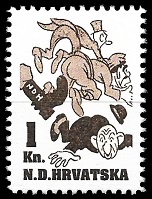
|
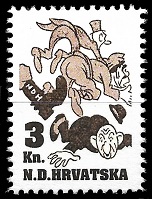
|
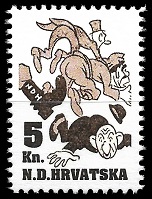
|
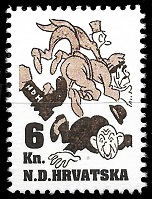
|
The series consists of stamps of 1 Kuna, 2 Kuna, 3 Kuna, 4 Kuna, 5 Kuna, 6 Kuna, 7 Kuna and 8 Kuna.
Date of issue : 10.4.1991.
|
|
|
|
|
|
Josip Broz Tito in Belgrade on October 12, 1944:
"A general amnesty is granted to all persons who participated in the units of Draža Mihajlovic".
|
|
|
|

|
Since then, the number of partisans in Serbia increased from 22,000 to 264,000 partisans who set out to "liberate" Croatia from 1,230,000 Croats with the support of domestic red traitors and to occupy Croatia.
For that Chetnik scum, the communist ideology was only one possibility to act in the spirit of the Great Serbian ideology under the red star!
|
|
|
|
|
|
Philatelic edition of the German military association "Handschar" : Communist monsters. Buy here : 
|
|
|
|
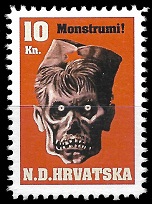
|
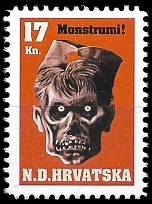
|

|
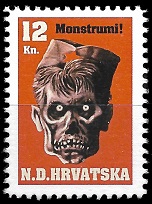
|
The series consists of stamps of 10 Kuna, 12 Kuna, 13 Kuna, 14 Kuna, 15 Kuna, 16 Kuna, 17 Kuna and 18 Kuna.
Date of issue : 10.4.1992.
|
|
|
|
|
|
|
|
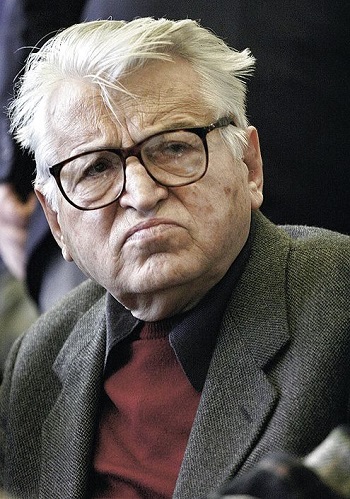
|
Serbian academic Dobrica Ćosić (left) in his book “Deobe” about his Serbs says on page 135 :
- “We lie to deceive ourselves, to console others; we lie out of pity, we lie out of shame, to encourage, to hide our misery, we lie out of honesty.
- We lie for freedom.
- A lie is a form of Serbian patriotism and a confirmation of our innate intelligence.
- We lie creatively, imaginatively, inventively.”
- “A lie is a Serbian state interest.”
- “A lie is in the very being of a Serb.”
- “In this country, every lie eventually becomes the truth.”
- “Serbs have been saved so many times in history by a lie…”
Dobrica Ćosić in her book "Deobe", (Otokar Keršovani, Rijeka, 1977) writes on page 168 :
- "It is a pity that in the Serbs, through six hundred years of slavery under the Turks, some well-known characteristics of slaves have developed to an incredible extent. In their national ethics, on the ranking list of virtues, lies come immediately after courage. Captain F., our expert on their history, admits that he does not know of any other people who, in national and political struggles, have been able to use the means of deception, trickery and lying to their opponents and enemies as successfully and happily as these skilled Serbs. They are real artists in lies."
A. G. Matoš also has something to say about the Serbs: "Serbs are a lie from God."
In Finland, even today, they say: "You lie like a Serb".
Great Montenegrin patriot dr. Sekula Drljević writes in "Balkan conflicts 1905-1941": "The word prank does not exist in any other nation in the neighborhood, but no one can prank like a Serb can!"
The Serbian president of the Helsinki Committee of Serbia, Sonja Biserko, says: "The entire Serbian history is a lie!"
Serbian "historian" Živko Andrijašević once said : "When we falsify, we don't do it a little at a time, we whitewash everything".
Patriarch Bartholomew to the Serbs: "You have been living in lies for 800 years!"
Sigmund Neumann wrote : "The history of Serbia is an endless struggle burdened with violence and lies, without borders, unknown among civilized countries. In that struggle in which lies, fraud, betrayal, revenge, murders, crimes are recognized as a normal rule of conduct. That is how the Serbian generations and the Chetniks grew up, as like-minded people of General Mihajlovic, so that political gang can be clarified without difficulty!"
"Along with the American and European lies, Serbian lies directed by Slobodan Milošević are equal, but more shameful and meaningless, and which are spread and multiplied by generals, politicians and journalists : the occupation of Kosovo is interpreted as the defense of the national unity and sovereignty. In a destroyed, crippled and defeated Serbia with thousands killed and wounded, a national victory is proclaimed. Farce after farce! The surrealism of history". The diary of Dobrica Ćosić, on the night when NATO stopped the bombing of Yugoslavia.
In 1871, the Serbian writer Milan Milicević wrote : "Our descendants cannot know the truth about us, because we do not tell it, but present what settles our account."
There is a famous saying in Croatia, Bosnia and Herzegovina and Montenegro : "There is no one who has what a Serb has, especially when he steals the language, territories and history from the Croats!".
|
|
|
|
|
|
|
|
|